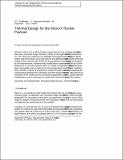Thermal Design for the Micro-X Rocket Payload
Author(s)
Goldfinger, David C.; Figueroa-Feliciano, Enectali; Danowski, Meredith E; Heine, Sarah N.T.
Download10909_2016_1549_ReferencePDF.pdf (1.419Mb)
PUBLISHER_POLICY
Publisher Policy
Article is made available in accordance with the publisher's policy and may be subject to US copyright law. Please refer to the publisher's site for terms of use.
Terms of use
Metadata
Show full item recordAbstract
Micro-X is a NASA funded, rocket borne X-ray imaging spectrometer that uses transition edge sensors (TESs) to do high-resolution microcalorimetry. The TESs are cooled by an adiabatic demagnetization refrigerator, whose salt pill functions as a heat sink for the detectors. We have made a thermal model of the cryostat with SPICE for the purposes of understanding its behavior at low temperatures. Implementing modifications based on this model has further allowed us to cool the system down to a lower temperature than had previously been accessible and to improve its low-temperature hold time. These modifications include a variety of schemes for power through heat sinks and tweaking the conductance between the cold baths and the refrigerated hardware. We present an overview of the model and its constituent parameters, information about thermal modifications, and a summary of results from thermal tests of the entire system.
Date issued
2016-02Department
Massachusetts Institute of Technology. Department of Physics; MIT Kavli Institute for Astrophysics and Space ResearchJournal
Journal of Low Temperature Physics
Publisher
Springer US
Citation
Goldfinger, D. C., E. Figueroa-Feliciano, M. Danowski, and S. N. T. Heine. “Thermal Design for the Micro-X Rocket Payload.” J Low Temp Phys 184, no. 3–4 (February 23, 2016): 699–705.
Version: Author's final manuscript
ISSN
0022-2291
1573-7357